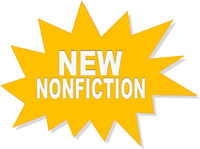 Nonfiction is in the spotlight and especially in the focus of the Common Core State Standards. However, in recent years nonfiction has also enjoyed popularity with readers as these informational books bring high quality photography and illustration techniques, primary documents, scientific photographs, narrative and poetic writing styles, and other writing features to the nonfiction arena. Wonderful writers that do extensive research are being honored through nonfiction awards like the Sibert Award from ALA or the Orbis Pictus Award from NCTE. Bloggers are helping to bring news about noteworthy nonfiction books through blogs like Nonfiction Monday, I.N.K. (Interesting Nonfiction for Kids), and the Nerdy Book Club Book Awards, to name just a few. Any school librarian can tell you that nonfiction has always been at the top of library circulation statistics. This week’s column from the International Reading Association's Children’s Literature and Reading Special Interest Group presents some of the newly published nonfiction titles for 2013.
Nonfiction is in the spotlight and especially in the focus of the Common Core State Standards. However, in recent years nonfiction has also enjoyed popularity with readers as these informational books bring high quality photography and illustration techniques, primary documents, scientific photographs, narrative and poetic writing styles, and other writing features to the nonfiction arena. Wonderful writers that do extensive research are being honored through nonfiction awards like the Sibert Award from ALA or the Orbis Pictus Award from NCTE. Bloggers are helping to bring news about noteworthy nonfiction books through blogs like Nonfiction Monday, I.N.K. (Interesting Nonfiction for Kids), and the Nerdy Book Club Book Awards, to name just a few. Any school librarian can tell you that nonfiction has always been at the top of library circulation statistics. This week’s column from the International Reading Association's Children’s Literature and Reading Special Interest Group presents some of the newly published nonfiction titles for 2013.
ReadWriteThink offers literally hundreds of lesson ideas for using nonfiction in every grade level classroom, and Reading Today Online features articles, discussions, and book reviews for nonfiction titles. Anita Silvey has written on the IRA Engage blog about her “picks” for award winning nonfiction.
GRADES K-3
Ajmera, Maya, Victoria Dunning, and Cynthia Pon. (2013). Healthy kids. Watertown, MA: Charlesbridge.
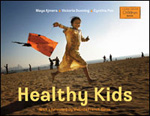 Through beautiful photographs, Ajmera has presented children from all over the world using the theme of being healthy. Cleary written for the preschool and primary age child, these photos and the accompanying text provide not only the global perspective of health related issues but present them in a double-page spread format to reinforce the importance and recognition of healthy lifestyles.
Through beautiful photographs, Ajmera has presented children from all over the world using the theme of being healthy. Cleary written for the preschool and primary age child, these photos and the accompanying text provide not only the global perspective of health related issues but present them in a double-page spread format to reinforce the importance and recognition of healthy lifestyles.
Using the themes of exercise and medical care, cleanliness and sanitation, protection from weather extremes, or clean water and healthy food, each picture portrays a different country, a different culture where family and community work together to keep their children healthy through an awareness of good health habits. Read more about this author and founder of the Global Fund for Children at her website.
- Karen Hildebrand, Ohio Library and Reading Consultant
Arlon, Penelope and Tony Gordon Harris. (2013). Emergency vehicles. New York: Scholastic.
 The cover and opening pages of this book begin with emergency vehicles that young children have probably seen like a fire engine or police car. Photographs, text, and fact boxes continue this picturesque look at other kinds of emergency vehicles like motorcycles, helicopters, and fireboats. After the first few pages young readers will see less familiar emergency transportation like the Superscooper that flies over forest fires, the lifeboat that rescues people from the ocean, the harness used to lift people from the water into the rescue helicopter and then on to ambulances, flying doctors and hospitals, and finally the search and rescue teams that go out and look for victims of disaster. Small charts that accompany each vehicle provide information as to how many crew members it takes to operate the vehicle and the entire book represents a tremendous amount of team work to the save lives of people in need.
The cover and opening pages of this book begin with emergency vehicles that young children have probably seen like a fire engine or police car. Photographs, text, and fact boxes continue this picturesque look at other kinds of emergency vehicles like motorcycles, helicopters, and fireboats. After the first few pages young readers will see less familiar emergency transportation like the Superscooper that flies over forest fires, the lifeboat that rescues people from the ocean, the harness used to lift people from the water into the rescue helicopter and then on to ambulances, flying doctors and hospitals, and finally the search and rescue teams that go out and look for victims of disaster. Small charts that accompany each vehicle provide information as to how many crew members it takes to operate the vehicle and the entire book represents a tremendous amount of team work to the save lives of people in need.
- Karen Hildebrand, Ohio Library and Reading Consultant
Arnold, Caroline. (2013). Too hot? Too cold? keeping body temperature just right. Illus. by Annie Patterson. Charlesbridge.
 Looking at both humans and animals the author talks about how creatures stay warm. Many science books for early readers present topics on hot and cold, but this book is really discussing how bodies work at keeping a safe temperature not only for comfort but also survival. Arnold presents facts about sweating as a heating and cooling activity, how blood expands and contracts within our veins to keep blood pulsing and bodies warm. She goes on to explains the facts about body fat, hair, fur and other body coverings, shelter, the use of water and other liquids, and even behavior and activity levels that create heat to stay warm or cool. The discussion of a variety of animals and their migration or hibernation patterns are presented and each animal is labeled and easily identified. A glossary and author notes are found at the end of this very informative book. Teachers will find several temperature related activities that go along with this book at the publisher’s blog, Unabridged.
Looking at both humans and animals the author talks about how creatures stay warm. Many science books for early readers present topics on hot and cold, but this book is really discussing how bodies work at keeping a safe temperature not only for comfort but also survival. Arnold presents facts about sweating as a heating and cooling activity, how blood expands and contracts within our veins to keep blood pulsing and bodies warm. She goes on to explains the facts about body fat, hair, fur and other body coverings, shelter, the use of water and other liquids, and even behavior and activity levels that create heat to stay warm or cool. The discussion of a variety of animals and their migration or hibernation patterns are presented and each animal is labeled and easily identified. A glossary and author notes are found at the end of this very informative book. Teachers will find several temperature related activities that go along with this book at the publisher’s blog, Unabridged.
- Karen Hildebrand, Ohio Library and Reading Consultant
Berne, Jennifer. (2013). On a beam of light: A story of Albert Einstein. San Francisco: Chronicle Books.
 Filled with illustrations created through gouache and pen and ink, this picture book biography somehow manages to make the almost ineffable personality and ponderings of Albert Einstein accessible to a young audience. The deftly chosen words and illustrations on the book’s pages bring to mind the famous physicist. Briefly covering Einstein’s formative years during which he quietly observed the world and became curious about its mysteries—"hidden and silent, unknown and unseen" (unpaged)—the book also provides a glimpse into the adult he became. Einstein’s initial curiosity with the world around him never faded, eventually morphing into a fascination with light, sound, and numbers. His interest in those particular topics eventually led to paradigm-shifting theories about the way we view the world. Children will enjoy reading about this great man's eccentricities such as his dislike for socks and his predilection for wandering barefoot around town while licking an ice cream cone. In the sure hands of this author and illustrator team, Einstein's strangeness is celebrated rather than mocked. Back matter includes author notes about Einstein. From start to finish this quirky title is a delight, especially since it encourages young readers to ask and find answers to the seemingly insoluble questions that puzzle them.
Filled with illustrations created through gouache and pen and ink, this picture book biography somehow manages to make the almost ineffable personality and ponderings of Albert Einstein accessible to a young audience. The deftly chosen words and illustrations on the book’s pages bring to mind the famous physicist. Briefly covering Einstein’s formative years during which he quietly observed the world and became curious about its mysteries—"hidden and silent, unknown and unseen" (unpaged)—the book also provides a glimpse into the adult he became. Einstein’s initial curiosity with the world around him never faded, eventually morphing into a fascination with light, sound, and numbers. His interest in those particular topics eventually led to paradigm-shifting theories about the way we view the world. Children will enjoy reading about this great man's eccentricities such as his dislike for socks and his predilection for wandering barefoot around town while licking an ice cream cone. In the sure hands of this author and illustrator team, Einstein's strangeness is celebrated rather than mocked. Back matter includes author notes about Einstein. From start to finish this quirky title is a delight, especially since it encourages young readers to ask and find answers to the seemingly insoluble questions that puzzle them.
- Barbara A. Ward, Washington State University Pullman
Gonzales, Doreen. (2013). The huge Pacific Ocean. Berkeley Heights, New Jersey: Enslow Publishers.
 The largest ocean on Earth, the Pacific Ocean occupies almost a third of the Earth’s surface. Its vast waters hold many seas: the Bering Sea, the South China Sea, and the Sea of Japan. Highlighting the Pacific, this book is divided into six chapters that allow exploration of the content in greater detail. The first chapter introduces ocean-related phenomenon such as tides, waves, and climate. The second chapter details the ocean’s resources such as food, energy, and the ocean’s other gifts. The ocean floor chapter deals with the ring of fire, hydrothermal vents, trenches, and mountains. The chapter on the ocean of life describes animal life in the oceans. The penultimate chapter summarizes the exploration of the ocean throughout history, even mentioning modern explorations. The final chapter deals with the health of the oceans by addressing topics such as conservation, endangered species, and pollution. This book is well written for its age group and will be a great resource for any classroom or library.
The largest ocean on Earth, the Pacific Ocean occupies almost a third of the Earth’s surface. Its vast waters hold many seas: the Bering Sea, the South China Sea, and the Sea of Japan. Highlighting the Pacific, this book is divided into six chapters that allow exploration of the content in greater detail. The first chapter introduces ocean-related phenomenon such as tides, waves, and climate. The second chapter details the ocean’s resources such as food, energy, and the ocean’s other gifts. The ocean floor chapter deals with the ring of fire, hydrothermal vents, trenches, and mountains. The chapter on the ocean of life describes animal life in the oceans. The penultimate chapter summarizes the exploration of the ocean throughout history, even mentioning modern explorations. The final chapter deals with the health of the oceans by addressing topics such as conservation, endangered species, and pollution. This book is well written for its age group and will be a great resource for any classroom or library.
- Rani Iyer, Washington State University Pullman
Guiberson, Brenda Z. (2013). Frog song. Illus. by Gennady Spirin. New York: Henry Holt.
 “CROAK! RIBBIT! Plonk! BRACK! Thrum-rum! Frogs have a song for trees, bogs, burrows and logs.” These are some of the opening lines to Frog Song, aptly named for the wonderful sounds and songs that emanate from this book. Teachers looking for a mentor text to teach onomatopoeia, look no further! Spirin’s beautiful double-page spread illustrations of frogs in their natural habitats around the globe provide the artistic backdrop for Guiberson’s poetic text about the music and sounds of frogs. From the strawberry poison dart frogs in Costa Rica to the tarantula-eating narrow-mouthed toad of Oklahoma to the Surinam toad with no tongue from Ecuador, each worldly frog is more interesting than the next. The author also sends out a strong environmental message at the end when she writes that frogs are in trouble: forests and plants are drying up and disappearing so the habitats for the frogs are gone and their songs will be silenced if we do not take care of the planet. This book is a science treasure, and the teaching guide that goes with it will be ever so helpful to teachers. The author and illustrator have worked together to create a beautiful resource guide with activities to accompany their book.
“CROAK! RIBBIT! Plonk! BRACK! Thrum-rum! Frogs have a song for trees, bogs, burrows and logs.” These are some of the opening lines to Frog Song, aptly named for the wonderful sounds and songs that emanate from this book. Teachers looking for a mentor text to teach onomatopoeia, look no further! Spirin’s beautiful double-page spread illustrations of frogs in their natural habitats around the globe provide the artistic backdrop for Guiberson’s poetic text about the music and sounds of frogs. From the strawberry poison dart frogs in Costa Rica to the tarantula-eating narrow-mouthed toad of Oklahoma to the Surinam toad with no tongue from Ecuador, each worldly frog is more interesting than the next. The author also sends out a strong environmental message at the end when she writes that frogs are in trouble: forests and plants are drying up and disappearing so the habitats for the frogs are gone and their songs will be silenced if we do not take care of the planet. This book is a science treasure, and the teaching guide that goes with it will be ever so helpful to teachers. The author and illustrator have worked together to create a beautiful resource guide with activities to accompany their book.
- Karen Hildebrand, Ohio Library and Reading Consultant
Smith, Danna. (2013). Balloon trees. Illus. by Laurie Allen Klein. Mount Pleasant, SC: Sylvan Dell Publishing.
 Told in rhyming text, this story of how a balloon begins first as rubber in a tree that must be tapped to release the sap is sure to interest curious young readers. The book describes all the steps in the balloon-making process, including singling out some balloons to be tested for quality. Few readers will have any idea of all the work that goes into producing the balloons that make a party festive. The colorful illustrations add to the book's interest, and make the subject even more interesting. Reading this book is bound to give readers a newfound appreciation for the story behind those short-lived rubber products that are so much fun to blow up, tie in a knot, and then bounce across a room or outside.
Told in rhyming text, this story of how a balloon begins first as rubber in a tree that must be tapped to release the sap is sure to interest curious young readers. The book describes all the steps in the balloon-making process, including singling out some balloons to be tested for quality. Few readers will have any idea of all the work that goes into producing the balloons that make a party festive. The colorful illustrations add to the book's interest, and make the subject even more interesting. Reading this book is bound to give readers a newfound appreciation for the story behind those short-lived rubber products that are so much fun to blow up, tie in a knot, and then bounce across a room or outside.
- Barbara A. Ward, Washington State University Pullman
GRADES 4-6
Doak, Robin S. (2012). Eleanor Roosevelt. Chicago: Heinemann Educational Books.
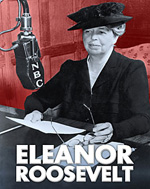 This short but informative biography about First Lady Eleanor Roosevelt covers her formative years and the causes that she came to champion, including rights for women and African-Americans. Unwilling to remain a figurehead by the side of her husband, Franklin D. Roosevelt, while he served as the nation's president, her example changed the role played by future First Ladies. It is no surprise that she was voted in polls as the most admired woman in the world 11 consecutive times. Independent and willing to speak her mind, Eleanor was also the object of ridicule and personal attacks. Accompanied by archival photographs showing this fierce advocate for social justice hard at work, the book contains several “Fact vs. Fiction” and “Did You Know” sections that demystify this ever-intriguing woman. Readers are likely to wonder about the factors that caused someone born to such wealth and privilege to care so deeply about making the world fair for others.
This short but informative biography about First Lady Eleanor Roosevelt covers her formative years and the causes that she came to champion, including rights for women and African-Americans. Unwilling to remain a figurehead by the side of her husband, Franklin D. Roosevelt, while he served as the nation's president, her example changed the role played by future First Ladies. It is no surprise that she was voted in polls as the most admired woman in the world 11 consecutive times. Independent and willing to speak her mind, Eleanor was also the object of ridicule and personal attacks. Accompanied by archival photographs showing this fierce advocate for social justice hard at work, the book contains several “Fact vs. Fiction” and “Did You Know” sections that demystify this ever-intriguing woman. Readers are likely to wonder about the factors that caused someone born to such wealth and privilege to care so deeply about making the world fair for others.
- Barbara A. Ward, Washington State University Pullman
Doyle, Oliver. (2012). Strange mysteries of the unexplained. New York: Scholastic.
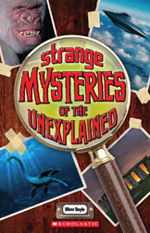 The four chapters in this book try to solve mysteries that have intrigued humans for decades and in some cases centuries. The mysteries concern the existence of cryptids, legendary creatures such as Bigfoot about whose existence there is no scientific proof, although there have been accounts and photographs purported to “prove” the existence of this taller than normal man. The second chapter explores the possibility of alien life forms and contact with creatures from beyond the Earth. Chapter three examines strange phenomena such as crop circles, the Bermuda triangle, the Nazca lines in Peru, Easter Island, and Stonehenge, among others. The last chapter looks into humans’ fascination with the so-called “lost” worlds of Atlantis, Lemuria, and Teotihuacan. Albeit brief, this is interesting reading that will inspire several spirited discussions about the possibilities of what might be out there, unknown to humans. The text is printed across colorful backgrounds and next to several photographs or drawings. While all the mysteries of the universe may not be explained in the book, the author offers several explanations.
The four chapters in this book try to solve mysteries that have intrigued humans for decades and in some cases centuries. The mysteries concern the existence of cryptids, legendary creatures such as Bigfoot about whose existence there is no scientific proof, although there have been accounts and photographs purported to “prove” the existence of this taller than normal man. The second chapter explores the possibility of alien life forms and contact with creatures from beyond the Earth. Chapter three examines strange phenomena such as crop circles, the Bermuda triangle, the Nazca lines in Peru, Easter Island, and Stonehenge, among others. The last chapter looks into humans’ fascination with the so-called “lost” worlds of Atlantis, Lemuria, and Teotihuacan. Albeit brief, this is interesting reading that will inspire several spirited discussions about the possibilities of what might be out there, unknown to humans. The text is printed across colorful backgrounds and next to several photographs or drawings. While all the mysteries of the universe may not be explained in the book, the author offers several explanations.
- Barbara A. Ward, Washington State University Pullman
Furgang, Kathy with Fred Hiebert. (2013). Everything money. Washington, D.C.: National Geographic.
 In a slightly oversize format, National Geographic Explorer Fred Hiebert and author Kathy Furgang present the concept of money. Beginning with a double-page spread photograph of shiny Euro coins, chapter one presents the history of bartering and the development of different kinds of money including currency, coins and paper from different corners of the world. Chapter 2, “From Rocks to Stocks,” has a timeline starting in the Stone Age up to present day depicting articles of value that have been used for money. Loaded with facts, figures and photos almost every imaginable aspect of money is covered in this book for young readers. A few different topics include why money matters, how money is made, how money is “retired,” how to become a billionaire, spending and saving money, crimes, heists and scams and finally some fun activities with money like origami and coin collecting. An interactive glossary is included at the end with index and further reading options.
In a slightly oversize format, National Geographic Explorer Fred Hiebert and author Kathy Furgang present the concept of money. Beginning with a double-page spread photograph of shiny Euro coins, chapter one presents the history of bartering and the development of different kinds of money including currency, coins and paper from different corners of the world. Chapter 2, “From Rocks to Stocks,” has a timeline starting in the Stone Age up to present day depicting articles of value that have been used for money. Loaded with facts, figures and photos almost every imaginable aspect of money is covered in this book for young readers. A few different topics include why money matters, how money is made, how money is “retired,” how to become a billionaire, spending and saving money, crimes, heists and scams and finally some fun activities with money like origami and coin collecting. An interactive glossary is included at the end with index and further reading options.
- Karen Hildebrand, Ohio Library and Reading Consultant
Gonzales, Doreen. (2013). What are the 7 wonders of the natural world? Berkeley Heights, NJ: Enslow.
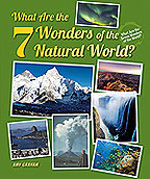 The ancient Greeks and Romans once listed the Seven Wonders of the World, all of which were man-made, and celebrated the ingenuity and brilliance of mankind. Among those were the Great Pyramid of Giza, the Hanging Gardens of Babylon, and the Colossus of Rhodes. In the same way that earlier humans paid tribute to wonders, this book pays homage to seven natural wonders. It's hard to argue with the choices of Mount Everest, Victoria Falls, the Grand Canyon, the Great Barrier Reef, the Northern Lights, the Paricutin Volcano, and the harbor of Rio de Janeiro. Each of these areas is beautiful and awe-inspiring in its own way, and the author's inclusion of information about how pollution and modern life are chipping away at some of these beautiful natural wonders strikes a cautionary note. Even though there are bits of information about how some of the wonders got their Anglo names, young readers will close the book wanting to know and see more of these special places. All in all, though, they’ll surely be struck with wonder at Nature’s infinite variety.
The ancient Greeks and Romans once listed the Seven Wonders of the World, all of which were man-made, and celebrated the ingenuity and brilliance of mankind. Among those were the Great Pyramid of Giza, the Hanging Gardens of Babylon, and the Colossus of Rhodes. In the same way that earlier humans paid tribute to wonders, this book pays homage to seven natural wonders. It's hard to argue with the choices of Mount Everest, Victoria Falls, the Grand Canyon, the Great Barrier Reef, the Northern Lights, the Paricutin Volcano, and the harbor of Rio de Janeiro. Each of these areas is beautiful and awe-inspiring in its own way, and the author's inclusion of information about how pollution and modern life are chipping away at some of these beautiful natural wonders strikes a cautionary note. Even though there are bits of information about how some of the wonders got their Anglo names, young readers will close the book wanting to know and see more of these special places. All in all, though, they’ll surely be struck with wonder at Nature’s infinite variety.
- Barbara A. Ward, Washington State University Pullman
Hague, Bradley. (2012). Alien deep; revealing the mysterious living world at the bottom of the ocean. Washington, D.C.: National Geographic.
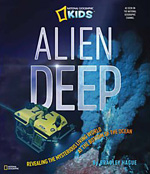 The companion to the five-part National Geographic TV special with the same name, Alien Deep is about the exciting discovery and exploration of the hydrothermal vents spewing into the ocean near the Galapagos Reef in the Pacific Ocean. With the characteristic and outstanding photography that National Geographic is noted for, this book travels with marine explorers detailing the events of the original expedition in 1977 to study plate tectonics on the ocean floor but leads to the discovery of these vents and the plant and animal life that thrive in the vicinity. Text features using small water bubbles provide definitions for some of the special vocabulary of oceanographers along with splashes of water that provide additional marine facts. Charts, diagrams, and photographs of the vehicles and monitoring equipment used to study these hydrothermals and the effects of the plant and animal surrounding them are explained as the 2011 return expedition probed further into this geological phenomenon. Named 2013 Outstanding Science Trade Book for Students K-12 by the National Science Teachers Association and the Children's Book Council.
The companion to the five-part National Geographic TV special with the same name, Alien Deep is about the exciting discovery and exploration of the hydrothermal vents spewing into the ocean near the Galapagos Reef in the Pacific Ocean. With the characteristic and outstanding photography that National Geographic is noted for, this book travels with marine explorers detailing the events of the original expedition in 1977 to study plate tectonics on the ocean floor but leads to the discovery of these vents and the plant and animal life that thrive in the vicinity. Text features using small water bubbles provide definitions for some of the special vocabulary of oceanographers along with splashes of water that provide additional marine facts. Charts, diagrams, and photographs of the vehicles and monitoring equipment used to study these hydrothermals and the effects of the plant and animal surrounding them are explained as the 2011 return expedition probed further into this geological phenomenon. Named 2013 Outstanding Science Trade Book for Students K-12 by the National Science Teachers Association and the Children's Book Council.
- Karen Hildebrand, Ohio Library and Reading Consultant
Krieger, Emily. (2013). Myths busted!: Just when you thought you knew what you knew. Illus. by Tom Nick Cocotos. Washington, DC: National Geographic Children’s Books.
 Urban legends seem to have longer shelf lives than just about any sort of story being spread. Just about everyone has heard, told, or believed an urban legend or myth about the origin of French fries or the fact that alligators live in the sewers of New York. There are plenty of myths or untruths swirling around bats, spiders, and even the dentures of George Washington. It’s nigh near impossible to trace the origins of these urban legends, but the author has plenty of fun telling the truth about them. Just as it is not true that the nation's first president wore dentures made from wood, none of the myths described in this book, often held as truths, has any credibility to them. Young readers will enjoy thumbing through the book in search of interesting facts and photographs they can share with others. As the adage would have it: The truth really is often stranger than fiction. This book offers plenty of examples why that is so.
Urban legends seem to have longer shelf lives than just about any sort of story being spread. Just about everyone has heard, told, or believed an urban legend or myth about the origin of French fries or the fact that alligators live in the sewers of New York. There are plenty of myths or untruths swirling around bats, spiders, and even the dentures of George Washington. It’s nigh near impossible to trace the origins of these urban legends, but the author has plenty of fun telling the truth about them. Just as it is not true that the nation's first president wore dentures made from wood, none of the myths described in this book, often held as truths, has any credibility to them. Young readers will enjoy thumbing through the book in search of interesting facts and photographs they can share with others. As the adage would have it: The truth really is often stranger than fiction. This book offers plenty of examples why that is so.
- Barbara A. Ward, Washington State University Pullman
Micklos, John. (2013). Washington’s crossing the Delaware and the winter at Valley Forge through primary sources. Berkeley Heights, NJ: Enslow Publishers.
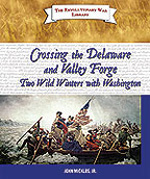 Relying on primary sources such as a cannon used during the colonial period, a map showing George Washington's military plans, a letter from the then-general asking Congress for money and supplies for his troops, and a jaw harp, this book describes vividly the challenges faced by the Patriot troops during the early years of the Revolutionary War. Because of the inclusion of stories of the hardships the Patriots faced and their fortune in snatching victories from the jaws of defeat, readers are likely to consider what might have been if the advantage had gone to the British or those hardy Americans had been unable to survive the winter and the lack of food and shelter. What if those volunteers in the army had decided to leave their posts? As is customary in books in this series, there are several photographs to bring the period to life. Especially impressive is how the book contains information about daily life in the military encampments and not only details about battles. Micklos spent many years working at the International Reading Association and was integral in the creation and development of Reading Today. Go to his website to schedule a visit to yiour school, library, or event.
Relying on primary sources such as a cannon used during the colonial period, a map showing George Washington's military plans, a letter from the then-general asking Congress for money and supplies for his troops, and a jaw harp, this book describes vividly the challenges faced by the Patriot troops during the early years of the Revolutionary War. Because of the inclusion of stories of the hardships the Patriots faced and their fortune in snatching victories from the jaws of defeat, readers are likely to consider what might have been if the advantage had gone to the British or those hardy Americans had been unable to survive the winter and the lack of food and shelter. What if those volunteers in the army had decided to leave their posts? As is customary in books in this series, there are several photographs to bring the period to life. Especially impressive is how the book contains information about daily life in the military encampments and not only details about battles. Micklos spent many years working at the International Reading Association and was integral in the creation and development of Reading Today. Go to his website to schedule a visit to yiour school, library, or event.
- Barbara A. Ward, Washington State University Pullman
Sandler, Martin. (2013). Why did the whole world go to war? … and other questions about World War II. Illus. by Robert Barrett. Sterling Children’s Books.
 For early students of history, this question and answer format on the topic of World War II is a starting place to look for basic answers that emerging readers might have about the War. Brightly colored illustrations that include maps add to the informational answers that are usually just a few paragraphs in length. Answers are brief but provide enough detail to give young readers a satisfying answer to their questions. A few of the questions that are easy to identify with younger readers include things like: What started the war? Why did the whole world go to war? Why was Anne Frank hiding? Who were the Tuskegee Airmen? and more. This will offer a beginning reference book to answer those very difficult questions.
For early students of history, this question and answer format on the topic of World War II is a starting place to look for basic answers that emerging readers might have about the War. Brightly colored illustrations that include maps add to the informational answers that are usually just a few paragraphs in length. Answers are brief but provide enough detail to give young readers a satisfying answer to their questions. A few of the questions that are easy to identify with younger readers include things like: What started the war? Why did the whole world go to war? Why was Anne Frank hiding? Who were the Tuskegee Airmen? and more. This will offer a beginning reference book to answer those very difficult questions.
- Karen Hildebrand, Ohio Library and Reading Consultant
Simon, Seymour. (2013). Seymour Simon’s Extreme oceans. San Francisco: Chronicle Books.
 The text and photographs in this engaging nonfiction title are sure to appeal to middle grade readers, especially those attracted to anything extreme, in this case, ocean extremes. The book contains twelve short chapters that explore oceans that are extremely warm and those that are extremely cold as well as the life-threatening enormous waves and tides that sweep in from the ocean’s depths so swiftly. In his usual straightforward style replete with interesting details, this nonfiction maven also covers tsunamis, hurricanes, and sea creatures so incredibly dangerous that no diver wants to encounter them, even briefly. Even those who know plenty about the world's oceans will still be able to add to that knowledge after reading this photograph-filled book. It has an ocean of interesting facts for readers to share with others.
The text and photographs in this engaging nonfiction title are sure to appeal to middle grade readers, especially those attracted to anything extreme, in this case, ocean extremes. The book contains twelve short chapters that explore oceans that are extremely warm and those that are extremely cold as well as the life-threatening enormous waves and tides that sweep in from the ocean’s depths so swiftly. In his usual straightforward style replete with interesting details, this nonfiction maven also covers tsunamis, hurricanes, and sea creatures so incredibly dangerous that no diver wants to encounter them, even briefly. Even those who know plenty about the world's oceans will still be able to add to that knowledge after reading this photograph-filled book. It has an ocean of interesting facts for readers to share with others.
- Barbara A. Ward, Washington State University Pullman
GRADES 5-8
Bolden, Tonya. (2013). Emancipation Proclamation: Lincoln and the dawn of liberty. New York: Abrams Books for Young Readers.
 Award-winning author Tonya Bolden brings another aspect of African American/American history to young readers that include viewpoints not often found in history textbooks. Using archival photographs, letters, documents, maps, newspaper articles, engravings, and posters, the visual impact along with her well-written narrative truly bring an accurate atmosphere of the time to this book. The debates and controversies, the proponents and abolitionists, the politicians and military all waited to hear the outcome of the passage of the Emancipation Proclamation as the book opens on January 1, 1863. Written in three parts: “The Agonizing Prayers of Centuries; A Fit and Necessary Military Measure; and The Trump of Jubilee,” Bolden uses a third-person viewpoint told by many people truly vested in the passage of this important history-making document. Part 2 is a narrative of the events and happenings. An extensive timeline is included in the book. Learn more about this author and her contribution to African American history at her website.
Award-winning author Tonya Bolden brings another aspect of African American/American history to young readers that include viewpoints not often found in history textbooks. Using archival photographs, letters, documents, maps, newspaper articles, engravings, and posters, the visual impact along with her well-written narrative truly bring an accurate atmosphere of the time to this book. The debates and controversies, the proponents and abolitionists, the politicians and military all waited to hear the outcome of the passage of the Emancipation Proclamation as the book opens on January 1, 1863. Written in three parts: “The Agonizing Prayers of Centuries; A Fit and Necessary Military Measure; and The Trump of Jubilee,” Bolden uses a third-person viewpoint told by many people truly vested in the passage of this important history-making document. Part 2 is a narrative of the events and happenings. An extensive timeline is included in the book. Learn more about this author and her contribution to African American history at her website.
- Karen Hildebrand, Ohio Library and Reading Consultant
Burgan, Michael. (2012). Breaker boys: how a photograph helped end child labor. Mankato, MN: Compass Point Books/Capstone Press.
 The use of photography to document history is the guiding theme of this series from Compass Point. In this particular volume the photos of Lewis Hines from the early 1900s and his visual witness to the child labor atrocities drove the movement to change these horrible conditions for children. Beginning with the heart-stopping oversized photo on the cover of the book, the story of child labor in the United States unfolds. Four chapters focus the content: Coal was King; Coal and Kids; Changing the World; and Ending Child Labor. Seeing small children covered in coal dust or standing on dangerous looms and frames in mills or climbing a cable high in the sky as the Empire State Building is constructed, these photographs speak volumes about the exploitive use of children in the labor market and how it was finally legislated and put to an end.
The use of photography to document history is the guiding theme of this series from Compass Point. In this particular volume the photos of Lewis Hines from the early 1900s and his visual witness to the child labor atrocities drove the movement to change these horrible conditions for children. Beginning with the heart-stopping oversized photo on the cover of the book, the story of child labor in the United States unfolds. Four chapters focus the content: Coal was King; Coal and Kids; Changing the World; and Ending Child Labor. Seeing small children covered in coal dust or standing on dangerous looms and frames in mills or climbing a cable high in the sky as the Empire State Building is constructed, these photographs speak volumes about the exploitive use of children in the labor market and how it was finally legislated and put to an end.
- Karen Hildebrand, Ohio Library and Reading Consultant
Burnie, David. (2013). Disasters. New York: Scholastic.
 Brimming with large pages filled with colorful photographs of disasters, this informative text highlights disastrous weather including tornadoes, hurricanes, avalanches, and extremely cold temperatures as well as those caused by unstable earth, and even water-caused disasters. There is even a chapter devoted to how humans cause disasters and possible disasters from space. The graphic features are the stars here as the book contains timelines, cutaways, and visuals that make readers feel as though they are right in the middle of the disasters being described. Many of the photographs will stay with readers long after the book has been closed, forcing them to see the damage caused to a Philippine highway by an earthquake in 2012 or a Romanian house almost engulfed by snow during a cold spell in the same year. Infinitely worth browsing, this book will prompt questions about Earth’s future while highlighting small and large acts of heroism.
Brimming with large pages filled with colorful photographs of disasters, this informative text highlights disastrous weather including tornadoes, hurricanes, avalanches, and extremely cold temperatures as well as those caused by unstable earth, and even water-caused disasters. There is even a chapter devoted to how humans cause disasters and possible disasters from space. The graphic features are the stars here as the book contains timelines, cutaways, and visuals that make readers feel as though they are right in the middle of the disasters being described. Many of the photographs will stay with readers long after the book has been closed, forcing them to see the damage caused to a Philippine highway by an earthquake in 2012 or a Romanian house almost engulfed by snow during a cold spell in the same year. Infinitely worth browsing, this book will prompt questions about Earth’s future while highlighting small and large acts of heroism.
- Barbara A. Ward, Washington State University Pullman
Callery, Sean. (2013). World War II. New York: Scholastic.
 "A visual history of the world’s darkest days” is the statement written across the bottom of the cover of this book, and it is certainly accurate in the visual impact of this book. Providing a barrage of information in the form of text, charts, diagrams, illustrations, newspapers, and sharp historic photography gives this book the feel of a webpage with the enormous amount of information on each page. Starting with the rise of Nazi Germany and the road to war this visual history continues with information on the Blitzkreig, the Holocaust, the Resistance, the London Blitz, the eastern front, and the Pacific Theater and so much more. In addition, photos of tanks, u-boats, airplanes, guns, and artillery are portrayed as well as small I.D. portrait photos of important leaders during the war. Students will enjoy looking at this book as it offers a plethora of World War II information.
"A visual history of the world’s darkest days” is the statement written across the bottom of the cover of this book, and it is certainly accurate in the visual impact of this book. Providing a barrage of information in the form of text, charts, diagrams, illustrations, newspapers, and sharp historic photography gives this book the feel of a webpage with the enormous amount of information on each page. Starting with the rise of Nazi Germany and the road to war this visual history continues with information on the Blitzkreig, the Holocaust, the Resistance, the London Blitz, the eastern front, and the Pacific Theater and so much more. In addition, photos of tanks, u-boats, airplanes, guns, and artillery are portrayed as well as small I.D. portrait photos of important leaders during the war. Students will enjoy looking at this book as it offers a plethora of World War II information.
- Karen Hildebrand, Ohio Library and Reading Consultant
Friedman, Mark. (2012). Human rights. Chicago: Heinemann Library.
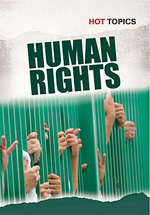 There is often quite a lot of talk about human rights in general, but sometimes it may not be clear, especially to young readers, what human rights are and who has them. Intended for teens, this book not only defines and explores human rights but also details how those rights have evolved over time and how they are interpreted in different ways in various countries. For instance, religious freedom is not a right in some nations, and historically, women and gays have struggled for basic rights in many countries. Interestingly, the author also includes a section on the digital divide and how lack of access to the Internet now puts many individuals at a disadvantage. The book also contains case studies that use real-life experiences to highlight the importance of basic rights. Appropriately, it also contains the United Nations Universal Declaration of Human Rights, 30 Articles that spell out the basic rights that all humans have. This is a thoughtful, useful title on an important topic. Including more photographs and a more design would have attracted more readers to what is arguably an important topic for these times.
There is often quite a lot of talk about human rights in general, but sometimes it may not be clear, especially to young readers, what human rights are and who has them. Intended for teens, this book not only defines and explores human rights but also details how those rights have evolved over time and how they are interpreted in different ways in various countries. For instance, religious freedom is not a right in some nations, and historically, women and gays have struggled for basic rights in many countries. Interestingly, the author also includes a section on the digital divide and how lack of access to the Internet now puts many individuals at a disadvantage. The book also contains case studies that use real-life experiences to highlight the importance of basic rights. Appropriately, it also contains the United Nations Universal Declaration of Human Rights, 30 Articles that spell out the basic rights that all humans have. This is a thoughtful, useful title on an important topic. Including more photographs and a more design would have attracted more readers to what is arguably an important topic for these times.
- Barbara A. Ward, Washington State University Pullman
Green, Jen. (2013). The impact of environmentalism: Conservation. Chicago, Illinois: Raintree.
 The “green” or environmental movement includes various groups across the globe, all united with a singular purpose—to protect all aspects of the living world, including the land, air, and oceans. This book introduces readers to deeper aspects of ecological conservation through eight chapters: What is conservation? What is environmentalism? Why conserve nature? Why conserve wildlife? Nature conservation, Wildlife conservation, What is the future of conservation? and What have we learned? Extended case studies, snapshot biographies of famous environmentalists, species profiles, and the special habitats on the Earth are all included in this book. Given the growth of environmentalism all over the world, it is difficult to cover the issues in all the continents in this slim volume. The volume focuses mostly on North America, Europe, with a few examples from Africa. The major gaps in the book are consumerism and the effect of growth of human population on natural resources. Still, this is a useful book for a class or school library.
The “green” or environmental movement includes various groups across the globe, all united with a singular purpose—to protect all aspects of the living world, including the land, air, and oceans. This book introduces readers to deeper aspects of ecological conservation through eight chapters: What is conservation? What is environmentalism? Why conserve nature? Why conserve wildlife? Nature conservation, Wildlife conservation, What is the future of conservation? and What have we learned? Extended case studies, snapshot biographies of famous environmentalists, species profiles, and the special habitats on the Earth are all included in this book. Given the growth of environmentalism all over the world, it is difficult to cover the issues in all the continents in this slim volume. The volume focuses mostly on North America, Europe, with a few examples from Africa. The major gaps in the book are consumerism and the effect of growth of human population on natural resources. Still, this is a useful book for a class or school library.
- Rani Iyer, Washington State University Pullman
Heos, Bridget. (2013). Stronger than steel: spider silk DNA and the quest for better bulletproof vests, sutures, and parachute rope. Photographs by Andy Comins. Houghton Mifflin.
 From the Scientists in the Field series that gave readers The Mighty Mars Rover and The Elephant Scientists, this fascinating book looks at the experiments scientists are doing with the golden orb weaver spider’s silk and its almost indestructible capabilities. Featuring the work and laboratory of scientist Randy Lewis he explains how he has spent a lifetime trying to find a way to create more of this super fiber that will possibly be used in making stronger medical sutures, for use with human ligaments, parachute ropes, body armor and more! Interestingly, the need for goats, and alfalfa that feeds the goats, and the goat milk that feeds the spiders is all part of the cycle being studied. The author explains how the DNA aspects of these materials are at the heart of recreating these elements of nature in the laboratory and genetic procedures used to create the transgenic plants and animals in this study. The small book with beautiful photographs is actually quite detailed in the scientific explanations provided for this fascinating look at the cycles of life that can be adapted for 21st century ideas.
From the Scientists in the Field series that gave readers The Mighty Mars Rover and The Elephant Scientists, this fascinating book looks at the experiments scientists are doing with the golden orb weaver spider’s silk and its almost indestructible capabilities. Featuring the work and laboratory of scientist Randy Lewis he explains how he has spent a lifetime trying to find a way to create more of this super fiber that will possibly be used in making stronger medical sutures, for use with human ligaments, parachute ropes, body armor and more! Interestingly, the need for goats, and alfalfa that feeds the goats, and the goat milk that feeds the spiders is all part of the cycle being studied. The author explains how the DNA aspects of these materials are at the heart of recreating these elements of nature in the laboratory and genetic procedures used to create the transgenic plants and animals in this study. The small book with beautiful photographs is actually quite detailed in the scientific explanations provided for this fascinating look at the cycles of life that can be adapted for 21st century ideas.
- Karen Hildebrand, Ohio Library and Reading Consultant
Perritano, John. (2013). National Geographic Kids: Everything Battles: Arm yourself with fierce photos and fascinating facts. Washington, DC: National Geographic Children’s Books.
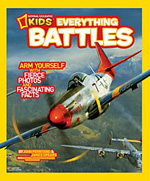 Divided into four sections, “Get Ready for Battle,” “The Battlefield,” “Weapons, Gadgets and Gear,” and “Military Exercises,” this title is packed with colorful photographs and interesting information about warfare, including the five battles considered to be the ultimate battles, an explanation of the military chain of command, facts about spies, and predictions of how wars will be fought in the future. Readers even have a chance to test their military savvy by answering strategy questions about what they might do if faced with military strategy questions. While the book's focus is war, the author has been careful to discuss the impact war has on civilians and the need for peace rather than war. Notes from a former war correspondent and colorful, large photographs add to the book's authenticity and appeal.
Divided into four sections, “Get Ready for Battle,” “The Battlefield,” “Weapons, Gadgets and Gear,” and “Military Exercises,” this title is packed with colorful photographs and interesting information about warfare, including the five battles considered to be the ultimate battles, an explanation of the military chain of command, facts about spies, and predictions of how wars will be fought in the future. Readers even have a chance to test their military savvy by answering strategy questions about what they might do if faced with military strategy questions. While the book's focus is war, the author has been careful to discuss the impact war has on civilians and the need for peace rather than war. Notes from a former war correspondent and colorful, large photographs add to the book's authenticity and appeal.
- Barbara A. Ward, Washington State University Pullman
GRADES 9-12
McConaghy, Lorraine and Judy Bentley. (2013). Free Boy--a true story of slave and master. Seattle: University of Washington.
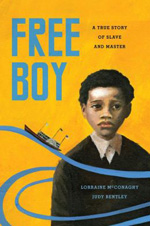 These two authors have researched a little known incident of the pre-Civil War history from the state of Washington. As the story goes based on a few scant records from the time, Charlie Mitchell is a slave that comes west with his master, James Tilton. James is a surveyor-general who settles in Olympia, Washington, in 1855. Five years later in 1860, Charlie escapes his slave master and begins his journey toward Canada and becomes the only known escaped slave to travel this Underground Railroad path aided by free blacks on his way to Canada. The authors have created a story and a possible life for Charlie in their novel but it definitely reflects the attitudes and mores of the time in our western most state that is not often included in African American historical annals.
These two authors have researched a little known incident of the pre-Civil War history from the state of Washington. As the story goes based on a few scant records from the time, Charlie Mitchell is a slave that comes west with his master, James Tilton. James is a surveyor-general who settles in Olympia, Washington, in 1855. Five years later in 1860, Charlie escapes his slave master and begins his journey toward Canada and becomes the only known escaped slave to travel this Underground Railroad path aided by free blacks on his way to Canada. The authors have created a story and a possible life for Charlie in their novel but it definitely reflects the attitudes and mores of the time in our western most state that is not often included in African American historical annals.
- Karen Hildebrand, Ohio Library and Reading Consultant
Miller, Brandon Marie. (2013). Women of the frontier; 16 tales of trailblazing homesteaders, entrereneurs and rabble-rousers. Chicago: Chicago Review Press.
 The author has used actual letters and journals to recreate sixteen first-hand accounts of the brave women who lived and pioneered the Old West. During the 1880s, as women journeyed west, they experienced unbelievable hardships, but their strength and courage left a legacy that is retold in their accounts of triumph in the American westward movement. Women from many walks of life have stories here including army wives, entertainers, an escaped slave, a survivor of the Donner Party disaster, and women who made a difference and got involved as political activists. New photographs add to this revised volume and the narrative writing style provides an engaging and compelling history of women. Note from the publisher: “Parts of this work were originally published as Buffalo gals: women of the Old West (Minneapolis, MN : Lerner Publishing, 1995). They have been substantially revised, updated, and expanded."
The author has used actual letters and journals to recreate sixteen first-hand accounts of the brave women who lived and pioneered the Old West. During the 1880s, as women journeyed west, they experienced unbelievable hardships, but their strength and courage left a legacy that is retold in their accounts of triumph in the American westward movement. Women from many walks of life have stories here including army wives, entertainers, an escaped slave, a survivor of the Donner Party disaster, and women who made a difference and got involved as political activists. New photographs add to this revised volume and the narrative writing style provides an engaging and compelling history of women. Note from the publisher: “Parts of this work were originally published as Buffalo gals: women of the Old West (Minneapolis, MN : Lerner Publishing, 1995). They have been substantially revised, updated, and expanded."
- Karen Hildebrand, Ohio Library and Reading Consultant
These reviews are submitted by members of the International Reading Association's Children's Literature and Reading Special Interest Group (CL/R SIG) and are published weekly on Reading Today Online. The International Reading Association partners with the National Council of Teachers of English and Verizon Thinkfinity to produce ReadWriteThink.org, a website devoted to providing literacy instruction and interactive resources for grades K–12.